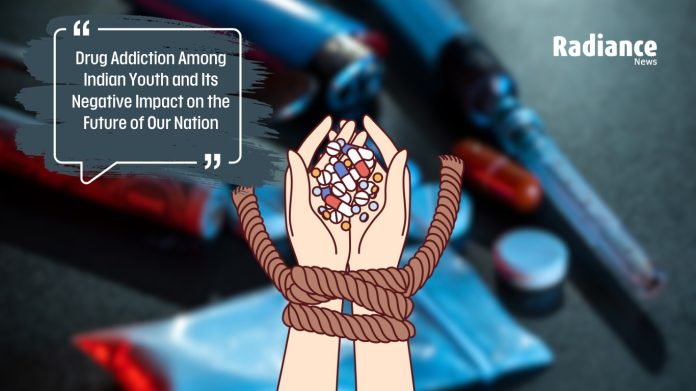While it is challenging to stop an intoxicated person from consuming, establishing counseling centers at the community, society, and workplace levels is crucial.

– Syed Ahmed Ali
According to the National Survey conducted by Ministry of Social Justice and Empowerment through NDDTC, AIIMS in 2018 on the Extent and Pattern of Substance Use in India and the estimated number of adults and children currently using various psychoactive substances, the most common substances are Alcohol, Cannabis, Opioids, Sedatives, Inhalants, Cocaine, ATS, and Hallucinogens, spanning the age range of 10–75 years. To gain insights and find a way forward, we have discussed the issue with the Campaign Convenor of De-addicting Goa 2.0, Suheb Naik as well as Areeba Neyazi and Mohd Waqar Ali.
 Suheb Naik, Campaign Convenor, De-addicting Goa 2.0
Suheb Naik, Campaign Convenor, De-addicting Goa 2.0
Drug addiction has become a global problem. Our country is no exception. The future of India is seriously threatened by the alarming rise in drug addiction cases among youth in the country in recent years.
According to a survey, around 15.8 million children between the ages of 10-17 are addicted to substances. States like Goa, Punjab, Mizoram, and Meghalaya have the highest cases of drug abusers. Reports on youth abusing substances are overwhelmingly high.
In India, drug addiction has emerged as a serious issue affecting not just the mental and physical health but also the socio-economic well-being of the nation. It has a huge impact on public health across various sections of the community and has potentially contributed to a massive increase in the crime rate. Not to forget the increase in Public Order offenses and the effects on family life and social instability.
Studies have repeatedly shown that addiction to substances affects not only the individuals involved but the entire ecosystem around them. As the drug epidemic slowly permeates every part of the country’s social and cultural fabric, it inevitably affects the youngest the most.
The youth of any country are considered integral. They play a pivotal role in shaping the present and future of the nation. For a country as densely populated as India, the youth make up one-fifth of the population. The moral, political, and social tenets of our nation will ultimately be decided by them.
Therefore, the drug addiction issue demands immediate collective action. By understanding the root causes and effects on the youth, society can work towards implementing effective preventive measures, fostering awareness, and providing support systems for those grappling with addiction. Only through concerted efforts can India hope to break free from the clutches of this increasing trouble and secure a healthier, more promising future for its youth.
 Areeba Neyazi, Pursuing Journalism and Mass Communication from Vivekananda Institute of Professional Studies, New Delhi
Areeba Neyazi, Pursuing Journalism and Mass Communication from Vivekananda Institute of Professional Studies, New Delhi
The prevalence of drug addiction among Indian youth is concerning and has serious implications for the country’s future. According to recent surveys, almost 15% of Indian adolescents are involved in substance misuse, which not only jeopardizes people’s well-being but also seriously undermines the social and economic fabric of the nation.
About 20% of youth become addicted to drugs because they are inexpensive and easily accessible, which can result in a variety of physical and mental health problems. This is also a factor in the quick expansion of this epidemic, which has been exacerbated by societal stress, peer pressure, and a lack of awareness.
Mental health, a cornerstone of a resilient and thriving youth population, takes a severe hit. Anxiety, depression, and other mental illnesses become common, affecting cognitive abilities and impeding personal growth.
Employability is negatively impacted as well. According to roughly 30% of employers, drug-addicted individuals exhibit reduced productivity and reliability. Individuals grappling with substance abuse often find it challenging to secure stable employment and financial dependency. Consequently, this acts as a barrier to the country’s progress hindering the growth of a skilled and competitive workforce.
Drug-related ailments are becoming more common, which drives up healthcare costs and now make up roughly 10% of all medical spending in the country. Furthermore, the societal ramifications are profound, with a surge in crime rates by almost 18%, linked to drug addiction. This jeopardizes the safety and security of society.
Addressing this menace requires a comprehensive approach, initiatives such as increased educational programs, accessible rehabilitation centres, and stringent law enforcement are crucial to curb the rising tide of drug addiction. Only through concerted efforts involving individuals, communities, and the government can we salvage the potential of our youth and safeguard the future of our great nation.
 Mohd Waqar Ali, Project Engineer BL Infra Projects Pvt. Ltd., Uttar Pradesh
Mohd Waqar Ali, Project Engineer BL Infra Projects Pvt. Ltd., Uttar Pradesh
Drug addiction has many common factors such as fashion, illiteracy, stress, and others. I have my own life experience to share through my observations. I have encountered drug addicts at three levels: 1. Students, 2. Post-Education, and 3. workplace
Drug addiction starts with fashion and ends with intoxication. I have witnessed many people justifying drug use, especially on campuses. It often begins within peer groups, where the environment created fosters a sense of freedom and peer pressure. Many students aiming to achieve their dreams become trapped in the name of freedom and peer influence.
Educational institutions need to be more vigilant and raise awareness among parents. The role of parents is crucial; many neglect monitoring their children’s peer groups. It is parents’ responsibility to keep an eye on their kids’ friends and create an environment where problems can be discussed. Additionally, instilling religious values and a sense of godliness among children is essential. These fundamental aspects can contribute to a drug-free life, paving the way for success.
Another important aspect is finding a balance between work life and work pressure. Many families have been destroyed by drug addiction. As a civil engineer, I have witnessed colleagues and workers succumb to alcohol addiction, resulting in accidents. Families are disrupted, and children often cannot pursue education due to a parent’s substance abuse. Families face financial crises, and the future of the children is jeopardized. To address these issues, decisive government action is required, such as banning manufacturing units. Eliminating the source is akin to killing the root of the evil; no manufacturer means no consumer. While it is challenging to stop an intoxicated person from consuming, establishing counseling centers at the community, society, and workplace levels is crucial. Another key measure is fostering religiousness and godliness, which can significantly contribute to building a better community, society, and future.




